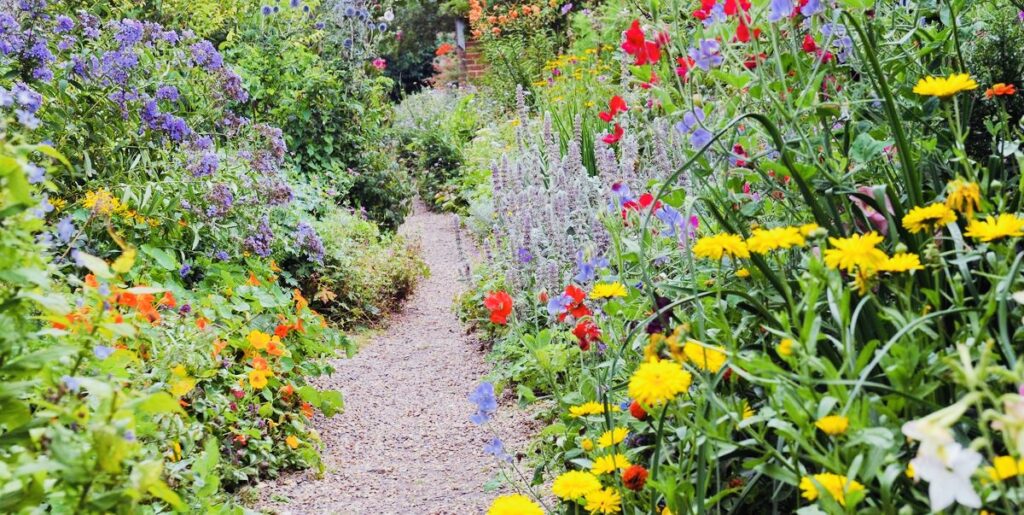
I’ve always wanted a yard with a magazine-cover-worthy flower garden. In my early gardening days, I’d begin working in Spring, spending weekends at the garden center in search of the perfect flowers for my landscape. Looking for an immediate color payoff, I’d choose as many annuals as I could since their blooms are the showiest and brightest. Once home, I’d work hard: digging holes, amending soil, making my additions and watering them in. I’d continue this weekend routine until late summer when the wonder of the landscape would reach its ultimate peak, bursting with vibrancy, a picturesque scene of birds and bees flittering among the blooms. It was almost like a “Home & Garden” cover– almost! But lovely as it was, it wouldn’t last. As summer faded, so too would the annuals. By mid-October, frost terminated the begonias, vincas and zinnias that filled the flower beds, leaving sad, crunchy botanical remains as my picture-perfect scene dissolved.
Then, I’d ignore the backyard until Spring returned when I would begin the process again, starting from scratch with the blooms, the holes, the soil amending and countless hours of hard work. While I enjoyed gardening and had success with what I planted, by early summer I’d be exhausted by the frenzy of digging. After years of doing this, I began to tire of the routine of starting all over every Spring. One day I happened upon a podcast with a master gardener. Listening, I realized I’d been leading a directionless gardening life, investing a lot of time (and money!) on a gardening routine that delivered no long-term payoff. Suddenly, I understood I needed to give up my devotion to short-lived annuals and invest in plants that would provide returns—like, they would literally return. I needed to be planting perennials, not annuals.
Admittedly, I had avoided planting perennials in the past because I was confused and intimidated by what it required. It seemed like so much work! There was a lot of work: according to the master gardener, in order to grow perennials successfully, I’d need to map out my garden and make plans for what I wanted the end result to be. I’d need to gather information about things like sun exposure and soil pH and consider a long-term goal for my garden. And of course, there would be the physical work. Although a little overwhelmed, I decided the payoff of a healthy, perennially growing garden would be worth it.
So I enlisted help of people who had more gardening skills than me to gather and plan. They taught me the importance of adding the right nutrients to the soil, the value of weeding and pruning, and the necessity of sticking to a plan. I learned what I could, then went home and did the digging and planting work. Incidentally, the work I required was pretty much the same work I had been doing when I planted annuals, only now I was working for ever-recurring results rather than short-term. Today, after years of perennial gardening, trying and failing, learning and growing, my backyard is a colorful collection of flora. Because I’ve tended the soil, made the amendments the experts suggested and continually prune and weed as I’m advised, the plants are healthy and vibrant each time they return.
Recently, I was thinking about gardening’s similarities to my health. I’ve always wanted to be an active person who exuded fitness and positivity. In the past, I addressed my wellness goals much the same way in which I headed to the garden center each Spring weekend: with short-term aspirations and looking for immediate payoffs. Like a good annual gardener on a quest for showy blooms, I’d work hard for several months to be “Bathing Suit Ready!” and would have some success. But at the end of the season, I had no real vision or consideration of what I hoped my overall health landscape would be. Then I’d stall, reverting to bad habits and poor health choices. I’d put my health goals away for a while and then return later, needing to start all over again.
I continued this way for a while (years!) until one day I was smart enough to ask for the guidance of someone wiser than me (like a master gardener!) who helped me see that what I needed was to apply the principles of perennial gardening to my health. Similar to my gardening endeavors, I needed to gather information about myself, make a long-term plan, and acquire new skills. Then, do the work! Just as with gardening, the work was not easy; it required intention and a willingness to change the soil in which my attitudes and behaviors are rooted. Also, I had to be patient. There are few quick payoffs; this process takes time. Today, it’s been nearly two years since I started, and I’m grateful to be enjoying the results of planting new habits for my health. I still struggle—there are just as many “weeds” in my pantry that need to be controlled as are in my flower beds it seems, and I definitely have bad habits I continue to prune. But just as I do in my garden, I treat it as a day-by-day exercise and not one that I start and stop abruptly with the seasons.
If you’re beginning this new year with the goal of better health, I’d encourage you to find a “master gardener” or an accountability partner (or both!) to come alongside you in support. Then, I’d urge you to practice small changes daily. Start small and focus on 1-2 behavior changes you know will help move you closer to your goal. For me, the first habit I addressed was drinking half my body weight in ounces of water daily. Once I was doing that consistently, I moved to the next habit of adding 2 more servings of fresh vegetables a day. Just as I didn’t replant my entire garden with a single trip to the nursery, I didn’t try to “fix” all my health habits in a week either. (If you want fun and helpful insight to habit change and goals, check out “Finish” by Jon Acuff.) And then, be patient. It will seem like it’s taking forever, but be faithful, it really will be happening. Like a little tiny seed sprouting, you’ll feel nothing until one day, you’ll be astonished to discover how much you’ve grown. It sounds hokey, perhaps cliché, but it also feels pretty amazing when you realize it’s happened to you. And it will.
If you’d like to share, I’d love to hear about your progress. Please, reach out and keep this dialogue going. Until then, happy growing!
